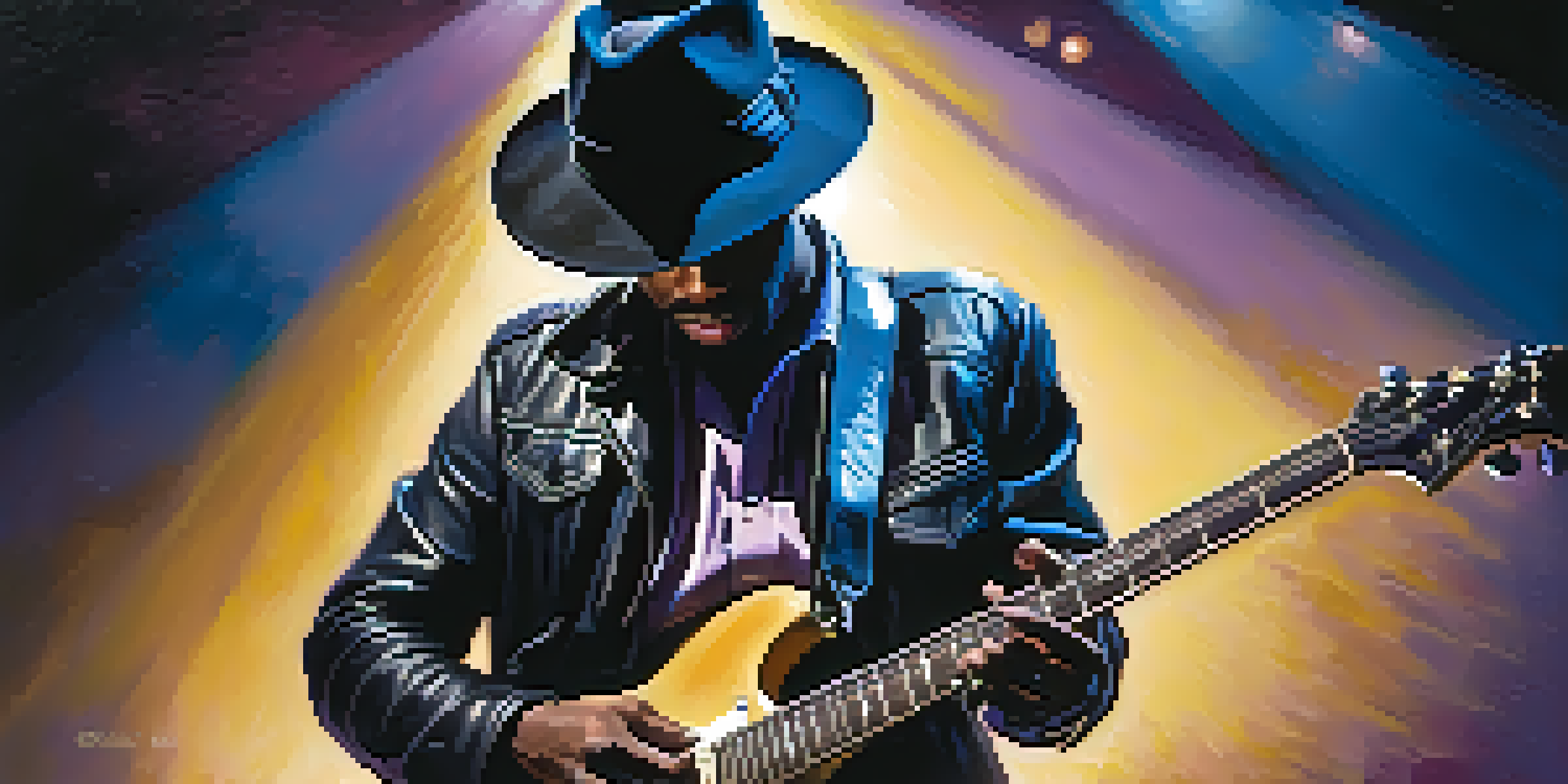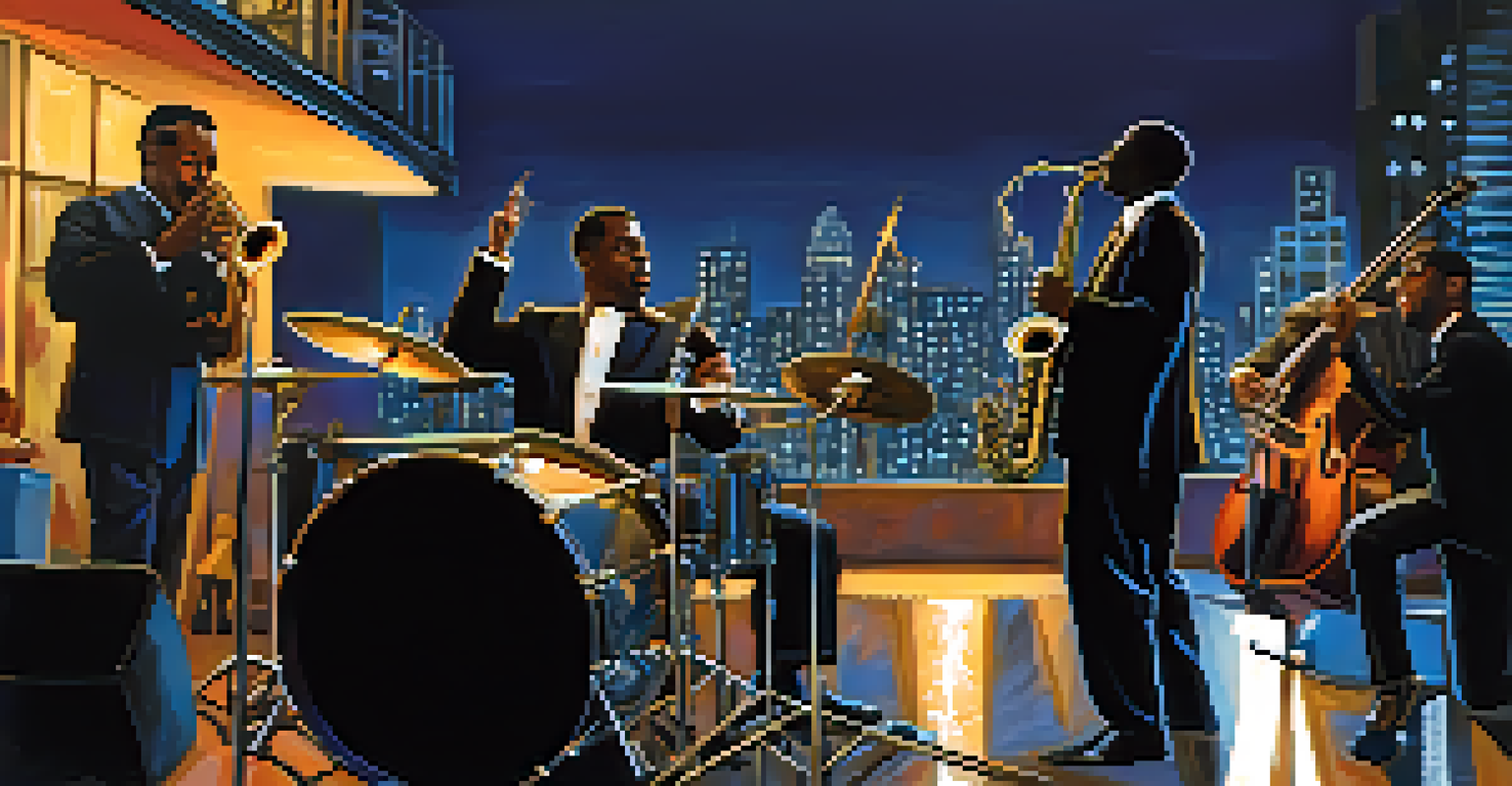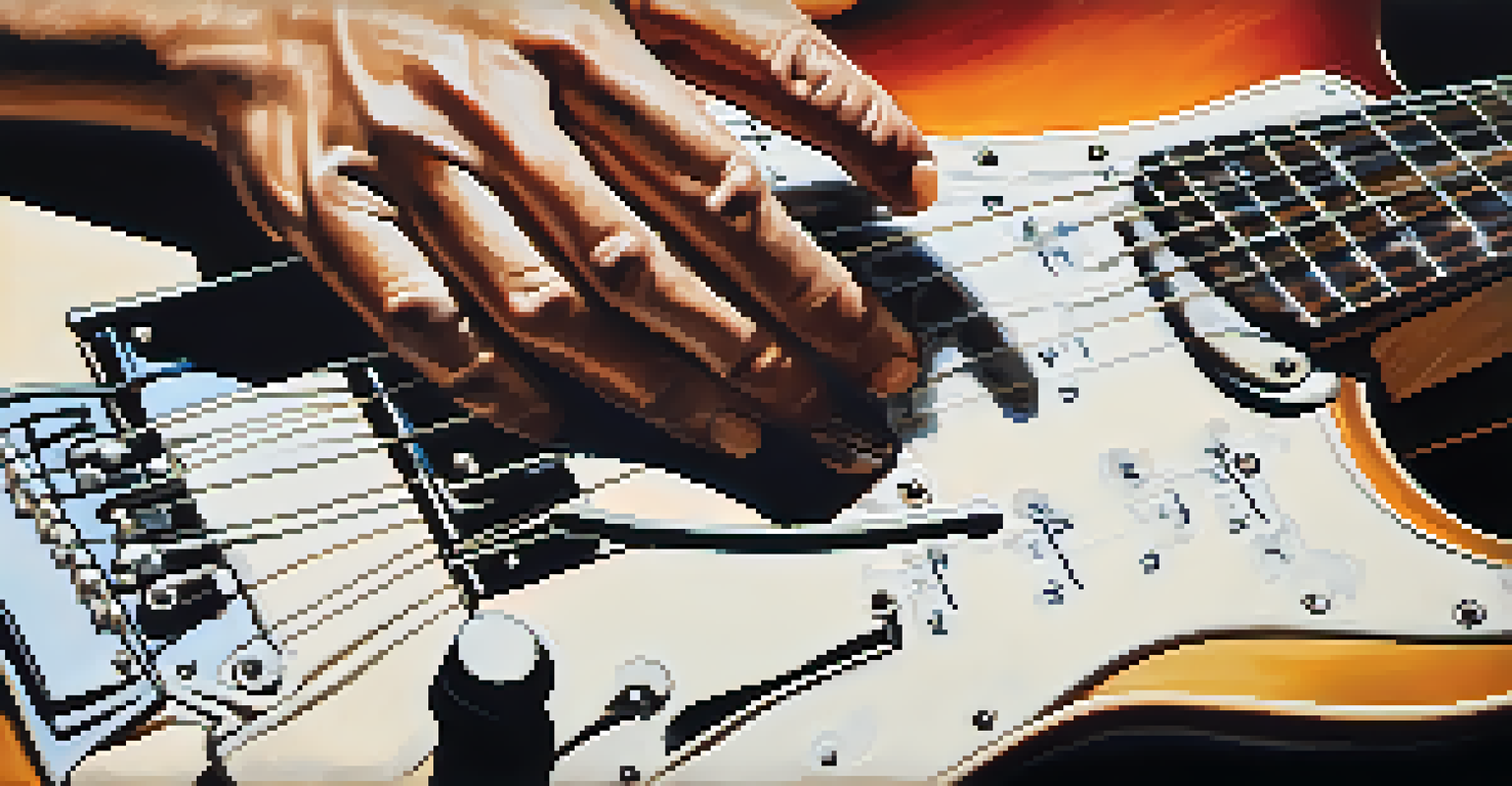The Influence of Blues on Jazz Guitar Improvisation

Understanding the Roots: Blues and Jazz Connection
Blues and jazz share a rich history rooted in African American music, with blues often seen as a precursor to jazz. The emotional depth of blues, characterized by its expressive melodies and themes of struggle, laid the groundwork for jazz's improvisational nature. As musicians transitioned from blues to jazz, they carried with them the essential elements that defined their sound.
The blues is a simple music, but it’s really deep too. It’s a crying music, a laughing music. It’s the music of life.
Both genres emphasize improvisation, but blues often adheres to a 12-bar structure, providing a framework for musicians to explore their creativity. This structure allows guitarists to experiment with melodic variations while staying true to the song's core. It’s not uncommon for jazz guitarists to incorporate blues elements, creating a seamless blend of styles that captivates audiences.
The cultural significance of blues also played a vital role in shaping jazz. As blues spread through the Southern United States, it influenced countless artists, introducing them to a world where expressing personal experiences through music became paramount. This narrative-driven approach is a hallmark of jazz, making the connection between the two genres even more profound.
The Role of the Minor Pentatonic Scale in Improvisation
One of the key tools in a jazz guitarist’s arsenal is the minor pentatonic scale, which has its roots in blues music. This scale consists of five notes, allowing for a wide range of expressive possibilities. Jazz guitarists utilize these notes to create solos that are both melodically rich and rhythmically engaging, often borrowing from traditional blues licks.

By incorporating the minor pentatonic scale into their improvisation, guitarists can evoke the raw emotion found in blues. This scale provides a familiar sound that resonates with listeners, making it easier for musicians to connect with their audience. For instance, a guitarist might begin with a classic blues riff before transitioning into more complex jazz phrases, showcasing their versatility.
Blues: The Foundation of Jazz
Blues music, with its emotional depth and structure, laid the groundwork for the improvisational nature of jazz.
The minor pentatonic scale isn’t just a tool; it’s a bridge that links the expressive power of blues with the sophisticated embellishments of jazz. This blend allows guitarists to navigate various musical landscapes, enhancing their improvisational skills. As they become more comfortable with this scale, players can experiment with different techniques, ultimately enriching their solos.
Blue Notes: Adding Emotion to Jazz Solos
In both blues and jazz, the use of 'blue notes' is essential for creating emotional depth. These notes, typically the flatted third and seventh, evoke feelings of melancholy and longing, allowing guitarists to express their innermost emotions. When jazz guitarists strategically incorporate blue notes into their solos, they transport listeners to a place filled with nostalgia and sentiment.
Jazz is about being in the moment, taking risks, and expressing yourself in a way that's uniquely you.
For example, a jazz guitarist might play a standard chord progression but add blue notes to their solo, creating a tension that enhances the overall mood. This practice not only adds a layer of complexity but also pays homage to the blues tradition. The result is a fusion of styles that feels both fresh and familiar, resonating with audiences on multiple levels.
The emotional impact of blue notes creates a conversational quality in jazz improvisation. Just like a heartfelt conversation, these notes convey a story, inviting listeners to engage with the music. As guitarists explore this technique, they find themselves drawing from their personal experiences, making each performance uniquely their own.
Crafting Unique Melodies Through Call and Response
The call and response technique, deeply rooted in both blues and jazz, plays a significant role in crafting memorable melodies. This approach involves a 'call' from the guitarist, followed by a 'response' from other instruments, creating a dynamic interaction. By mastering this technique, jazz guitarists can weave intricate narratives within their solos.
For instance, a guitarist may play a melodic phrase that serves as a call, prompting a piano or saxophone to respond with a complementary line. This dialogue not only enhances the improvisation but also fosters a sense of collaboration among musicians. It’s a beautiful representation of how blues influences the communal aspect of jazz.
Minor Pentatonic Scale's Importance
The minor pentatonic scale connects blues and jazz, allowing guitarists to express rich melodies and emotions in their solos.
As jazz guitarists experiment with call and response, they develop a greater understanding of musical conversation. This technique encourages them to listen actively and respond creatively, enriching their improvisational skills. Ultimately, the interplay of call and response adds a vibrant layer to jazz performances, showcasing the lasting influence of blues.
Rhythmic Elements: Swing and Shuffle in Jazz Guitar
Rhythm is a crucial aspect of both blues and jazz, with each genre offering unique rhythmic elements that shape their identities. The swing feel, characterized by its uneven eighth notes, is a hallmark of jazz that creates a lively, infectious energy. In contrast, the shuffle rhythm, common in blues, provides a more laid-back groove that invites listeners to sway along.
Jazz guitarists often blend these rhythmic elements in their improvisation, creating a distinctive sound that pays homage to both genres. For example, a guitarist might start with a shuffle rhythm and then transition to a swing feel, showcasing their versatility and command of rhythm. This fluidity allows them to explore various musical ideas while keeping the audience engaged.
By mastering these rhythmic techniques, jazz guitarists can create solos that are not only melodically interesting but also rhythmically compelling. The interplay between swing and shuffle adds depth to their music, demonstrating the enduring influence of blues on jazz. This fusion of rhythms invites audiences to experience the joy and complexity of both genres.
Famous Guitarists: Icons of Blues and Jazz Fusion
Throughout history, numerous guitarists have exemplified the fusion of blues and jazz, each leaving an indelible mark on the music world. Legends like B.B. King and Wes Montgomery showcased their mastery of both styles, blending bluesy phrases with intricate jazz harmony. Their innovative approaches continue to inspire new generations of musicians.
B.B. King, known for his expressive bending of notes, infused his blues background into jazz improvisation, creating a unique sound that resonates with listeners. Similarly, Wes Montgomery’s use of octaves and complex chord progressions showcases how a guitarist can navigate both genres effortlessly. These icons demonstrate the power of blending influences to create something entirely new.
Famous Guitarists Blend Styles
Icons like B.B. King and Wes Montgomery demonstrate how blending blues and jazz influences can create innovative musical expressions.
The impact of these guitarists extends beyond their recordings; they have shaped the way musicians view improvisation. By embracing both blues and jazz elements, they have encouraged aspiring guitarists to explore their own musical identities. In doing so, they highlight the significance of blues in the evolution of jazz guitar improvisation.
The Future of Jazz Guitar: Continuing the Blues Legacy
As jazz continues to evolve, the influence of blues remains ever-present, shaping the sounds of contemporary guitarists. New artists are finding innovative ways to incorporate blues techniques into their jazz improvisation, ensuring that this rich legacy endures. By experimenting with different styles and blending genres, today’s musicians are pushing the boundaries of what jazz can be.
For instance, modern jazz guitarists often draw inspiration from various genres, including rock and funk, while still paying homage to their blues roots. This fusion creates a fresh sound that resonates with a diverse audience, proving that the influence of blues is far from fading. The ability to adapt and innovate is a testament to the enduring power of these foundational styles.

Ultimately, the future of jazz guitar improvisation will continue to reflect the influence of blues, as musicians explore new avenues of expression. By honoring the past while embracing the present, they create a vibrant musical landscape that captivates listeners. The ongoing dialogue between blues and jazz ensures that this rich tradition will thrive for generations to come.